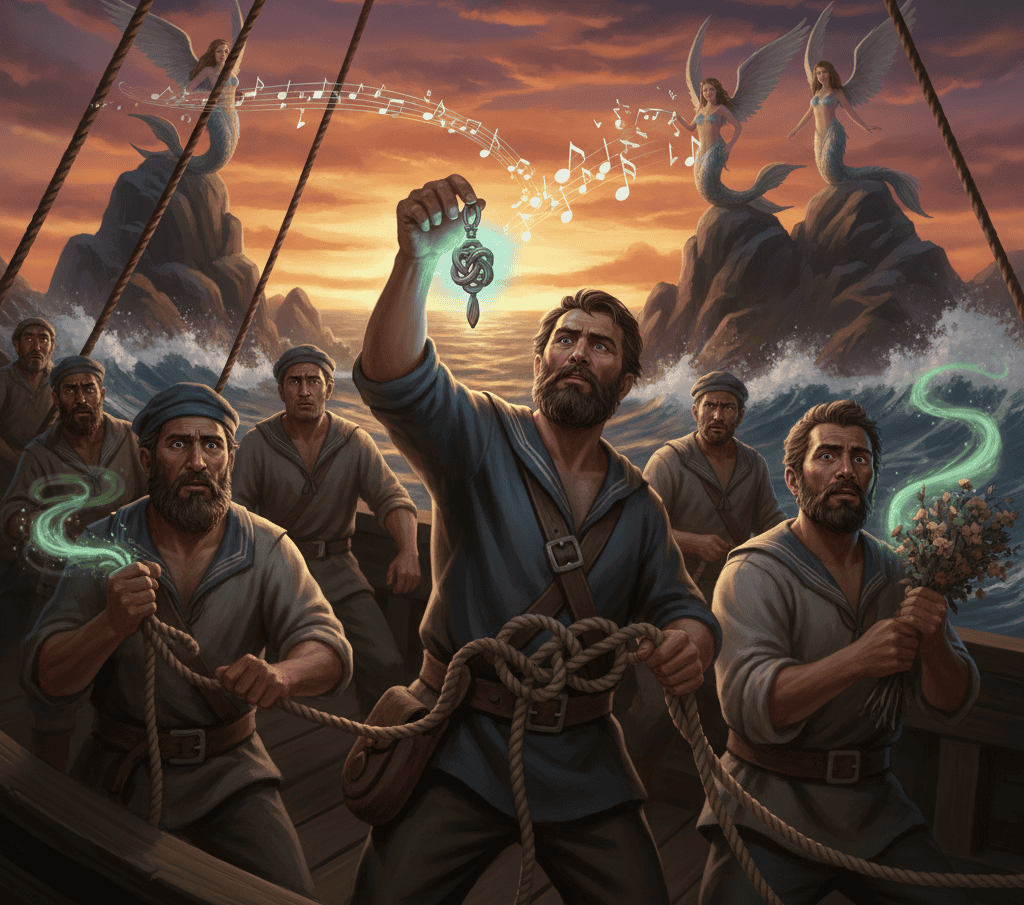The waters were unpredictable, storms could rise from nowhere, and lurking in the waves were creatures like the sirens, whose voices promised knowledge and beauty but delivered only death.
Everyone knew their song was irresistible, and yet sailors kept daring to cross dangerous waters. How did sailors manage?
They developed clever, desperate, and sometimes downright strange ways to protect themselves from sirens.
Let’s explore seven of the most memorable methods that kept sailors alive when temptation called from the rocks.
1. Plugging Their Ears With Wax
The most famous method comes straight from Homer’s Odyssey. Odysseus, warned about the sirens, ordered his men to plug their ears with beeswax.
This simple yet brilliant trick made them deaf to the deadly songs. With their hearing blocked, the sailors rowed safely past while Odysseus, tied to the mast, struggled against the ropes in torment as the sirens sang to him alone.
This method worked because it acknowledged human weakness. Odysseus knew that no mortal could resist the sirens’ song by willpower alone.
Instead of trying to fight temptation, he silenced it. The image of hardened sailors with wax stuffed in their ears has become one of the most enduring symbols of discipline against irresistible danger.
2. Binding Themselves To The Mast
Odysseus also introduced another clever tactic. Since he longed to hear the sirens’ voices but did not want to die for the privilege, he had his crew tie him tightly to the mast of the ship.
No matter how much he begged or threatened, they were forbidden to release him until the danger passed.
This trick showed an understanding of how strong desire can be. Odysseus admitted he was not above temptation, so he created a safeguard that would hold him even when his own will betrayed him.
The bound captain straining against his ropes while the crew rowed on deaf and steady became an iconic image of both vulnerability and resilience at sea.
3. Steering Away From Siren Waters
Many sailors took a more cautious approach: they simply avoided the regions rumored to be haunted by sirens.
Tales spread quickly among seafarers, and if a certain stretch of coast was said to echo with beautiful voices, most would change their course even if it meant days of delay.
This avoidance was not cowardice but wisdom. Sailors already faced countless risks on the open sea, from pirates to storms.
Why add supernatural danger into the mix? Avoidance became one of the first protective strategies against sirens, a recognition that sometimes survival depends on refusing to take the risk at all.
4. Playing Louder Music
Not every sailor could steer clear of siren waters, so some tried to fight sound with sound. Legends tell of crews who carried flutes, drums, or even entire choruses of singers to drown out the sirens’ voices.
By filling their ship with noise, they hoped the deadly melody would be muffled or lost in the din.
This tactic turned into a battle of music. The sirens’ song was said to be irresistible because of its clarity and harmony, but if the sailors kept their ears filled with their own rhythms, they might resist long enough to row past.
Imagine a crew beating drums with wild determination while the haunting voices of sirens floated across the waves.
It was a contest between mortal noise and divine enchantment, and sometimes, noise alone was enough to win.
5. Seeking Help From The Gods
Sailors also turned to divine protection. Some prayed to sea deities like Poseidon or Nereus before setting sail, asking for safe passage and protection from the sirens’ call.
Others wore charms dedicated to gods who could counter temptation, such as Hermes, known for his cleverness, or Athena, the goddess of wisdom.
In some traditions, offerings were cast into the sea as bribes or tokens of respect, hoping the spirits of the waves would shield them.
These rituals reveal how deeply sailors believed the sea was filled with both danger and divinity. Protection from sirens was not only physical but spiritual, calling upon higher powers to silence or redirect the monsters’ influence.
6. Trusting The Helmsman
Another method lies in discipline and trust. The helmsman, who steered the ship, often remained the most focused and disciplined member of the crew.
In some tales, sailors trusted their helmsman to stay steady even when others faltered. If the crew was entranced, it was the helmsman’s job to keep the ship pointed away from danger until the voices faded.
This tactic highlighted the importance of leadership on the sea. When chaos broke out, one person had to remain calm and focused.
The helmsman became a kind of anchor for the ship, a reminder that survival depended on both courage and clear direction.
7. Embracing Sailor Superstitions
Sailors were famously superstitious, and many carried charms or practiced rituals to guard against supernatural threats.
Some believed carved talismans or knots tied in ropes held protective magic. Others recited chants or carried herbs thought to ward off enchantment.
These superstitions may not have silenced the sirens, but they gave sailors confidence. In the uncertain world of the sea, belief in a charm’s power could mean the difference between panic and composure.
And sometimes, courage itself was enough to keep a crew rowing strong past the sirens’ dangerous rocks.

私は生まれたときから、常に神との強いつながりを感じていた。作家として、また指導者として、私の使命は、人々が最も暗い時代に愛と幸福と内なる強さを見つけるのを助けることである。








